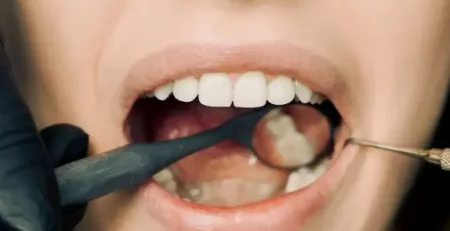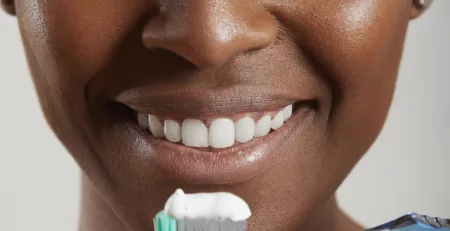Can Toothpaste Really Repair Enamel? Exploring the Claims
Introduction
Toothpaste and Enamel Repair
Tooth enamel is the hard, outer layer of your teeth that protects them from decay, sensitivity, and staining. It is composed of minerals such as calcium, phosphate, and hydroxyapatite.
However, tooth enamel is not indestructible. It can be eroded by acidic foods and drinks, bacteria, plaque, and abrasion.
Once tooth enamel is damaged, it cannot be regenerated by the body. This can lead to various dental problems such as cavities, toothache, and discolouration.
So, is there such thing as Toothpaste and Enamel Repair?
Some toothpaste brands claim that they can restore or re-mineralise tooth enamel by delivering essential minerals to the teeth.
But how effective are these claims? And what are the best toothpastes for enamel repair?
In this article, we will explore the science behind tooth enamel repair and review some of the products that promise to strengthen your teeth.
How does tooth enamel repair work?
To understand how tooth enamel repair works, we need to know how tooth enamel erosion happens.
Tooth enamel erosion occurs when the pH level in your mouth drops below 5.5, which is the critical point for enamel dissolution¹.
This can happen when you consume acidic foods and drinks such as citrus fruits, vinegar, soda, wine, and coffee. These substances lower the pH level in your mouth and dissolve the minerals in your enamel.
However, your saliva can help to neutralise the acidity and remineralise your enamel. Saliva contains minerals such as calcium, phosphate, and fluoride that can bond with the enamel surface and form a protective layer. This process is called remineralisation and it can reverse early stages of enamel erosion.
If the acid attack is too frequent or too severe, your saliva may not be able to keep up with the mineral loss.
This can result in permanent damage to your enamel and expose the underlying dentin layer. Dentin is softer and more porous than enamel and it contains nerve endings that can cause sensitivity and pain.
How Toothpastes can help with Enamel
This is where toothpaste comes in.
Some toothpastes contain fluoride, which is a mineral that can strengthen enamel and prevent cavities.
Fluoride works by replacing some of the hydroxyapatite molecules in your enamel with fluorapatite molecules, which are more resistant to acid².
Other toothpastes contain hydroxyapatite or calcium phosphate nanoparticles, which are similar to the natural minerals in your enamel.
These particles can penetrate the microcracks and pores in your enamel and fill them up with new mineral crystals³.
This can restore the smoothness and hardness of your enamel and improve its appearance.
What are the best toothpastes for enamel repair?
There are many toothpastes on the market that claim to repair or remineralise tooth enamel.
However, not all of them are equally effective or suitable for everyone. Here are some of the factors that you should consider when choosing a toothpaste for enamel repair:
- The type and amount of minerals in the toothpaste: Different minerals have different effects on your enamel. Fluoride is widely accepted as the most effective mineral for preventing cavities and strengthening enamel⁴. However, some people may be allergic or sensitive to fluoride or prefer a natural alternative. Hydroxyapatite and calcium phosphate are also proven to remineralise enamel and reduce sensitivity, but they may not be as widely available or affordable as fluoride.
- The abrasiveness of the toothpaste: Abrasiveness refers to how much a toothpaste can scratch or wear away your enamel. While some abrasion is necessary to remove plaque and stains, too much abrasion can damage your enamel and make it more prone to erosion. You can check the abrasiveness of a toothpaste by looking at its Relative Dentin Abrasivity (RDA) value, which ranges from 0 to 250. The lower the RDA value, the less abrasive the toothpaste is.
- The pH level of the toothpaste: pH level refers to how acidic or alkaline a substance is. As mentioned earlier, acidic substances can dissolve your enamel while alkaline substances can neutralise them. Therefore, you should avoid using a toothpaste that has a pH level lower than 5.5, which is the critical point for enamel dissolution. You can test the pH level of a toothpaste by using a pH strip or meter.
- The flavour and texture of the toothpaste: Flavour and texture are personal preferences that can affect how often and how well you brush your teeth. You should choose a toothpaste that has a flavour and texture that you like and that does not irritate your mouth. Some toothpastes may contain artificial sweeteners, colours, or preservatives that can cause allergic reactions or sensitivity in some people. You can check the ingredients list of a toothpaste to see what it contains and avoid any potential allergens or irritants.
Based on these factors, here are some examples of toothpastes that claim to repair or remineralise tooth enamel and how they compare:
- Sensodyne Repair & Protect: This is a fluoride toothpaste that claims to repair sensitive teeth by forming a protective layer over the exposed dentin. It has an RDA value of 79, which is considered medium abrasive, and a pH level of 6.8, which is slightly alkaline. It has a minty flavour and a smooth texture.
- Regenerate Advanced: This is a hydroxyapatite toothpaste that claims to reverse early enamel erosion and restore the natural whiteness of your teeth. It has an RDA value of 116, which is considered high abrasive, and a pH level of 8.3, which is very alkaline. It has a fresh mint flavour and a creamy texture.
- BioMin F: This is a fluoride toothpaste that claims to release low levels of fluoride, calcium, and phosphate over several hours to remineralise your enamel and protect it from acid attack. It has an RDA value of 60, which is considered low abrasive, and a pH level of 7.2, which is neutral. It has a mild mint flavour and a gel-like texture.
As you can see, each toothpaste has its own advantages and disadvantages when it comes to repairing or remineralising tooth enamel.
You may need to try different products and see what works best for you and your teeth.
You should also consult your dentist before using any new toothpaste, especially if you have any existing dental conditions or concerns.
Conclusion
Tooth enamel repair is possible with the help of toothpaste that contains minerals such as fluoride, hydroxyapatite, or calcium phosphate.
These minerals can replenish the lost ones in your enamel and make it stronger and more resistant to decay and sensitivity.
However, not all toothpastes are equally effective or suitable for everyone. You should consider the type and amount of minerals, the abrasiveness, the pH level, and the flavour and texture of the toothpaste before choosing one.
You should also consult your dentist before using any new toothpaste, especially if you have any existing dental conditions or concerns.
References
(1) How to Remineralise Teeth at Home and Repair Enamel – Dentaly. https://www.dentaly.org/en/oral-health/enamel-repair-remineralization/.
(2) Dental treatments – NHS. https://www.nhs.uk/live-well/healthy-teeth-and-gums/dental-treatments/.
(3) Enamel Erosion Repair | Penn Dental Family Practice. https://mypenndentist.org/dental-tips/2021/04/22/how-do-you-fix-tooth-enamel/.
(4) Can Tooth Enamel Be Restored? | Colgate®. https://www.colgate.com/en-us/oral-health/adult-oral-care/can-tooth-enamel-be-restored.



Leave a Reply